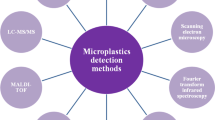Abstract
Plastic pollution has been a legacy environment problems and more recently, the plastic particles, especially those ultrafine or small plastics particles, are widely recognized with increasing environmental and ecological impacts. Among small plastics, microplastics are intensively studied, whereas the physicochemical properties, environmental abundance, chemical states, bioavailability and toxicity toward organisms of nanoplastics are inadequately investigated. There are substantial difficulties in separation, visualization and chemical identification of nanoplastics due to their small sizes, relatively low concentrations and interferences from coexisting substances (e.g., dyes or natural organic matters). Moreover, detection of polymers at nanoscale is largely hampered by the detection limit or sensitivity for existing spectral techniques such as Transformed Infrared Spectroscopy (FTIR) or Raman Spectroscopy. This article critically examined the current state of art techniques that are exclusively reported for nanoplastic characterization in environmental samples. Based on their operation principles, potential applications and limitations of these analytical techniques are carefully analyzed.

Similar content being viewed by others
References
Bianco A, Passananti M (2020). Atmospheric micro and nanoplastics: An enormous microscopic problem. Sustainability, 12(18): 7327
Correia M, Loeschner K (2018). Detection of nanoplastics in food by asymmetric flow field-flow fractionation coupled to multi-angle light scattering: possibilities, challenges and analytical limitations. Analytical and Bioanalytical Chemistry, 410(22): 5603–5615
Fu W, Zhang W (2017). Hybrid AFM for nanoscale physicochemical characterization: Recent development and emerging applications. Small, 13(11): 1603525
Hurley R R, Lusher A L, Olsen M, Nizzetto L (2018). Validation of a method for extracting microplastics from complex, organic-rich, environmental matrices. Environmental Science & Technology, 52(13): 7409–7417
Jiménez-Lamana J, Marigliano L, Allouche J, Grassl B, Szpunar J, Reynaud S (2020). A novel strategy for the detection and quantification of nanoplastics by single particle inductively coupled plasma mass spectrometry (ICP-MS). Analytical Chemistry, 92(17): 11664–11672
Lambert S, Wagner M (2016). Characterisation of nanoplastics during the degradation of polystyrene. Chemosphere, 145: 265–268
Materić D, Ludewig E, Brunner D, Röckmann T, Holzinger R (2021). Nanoplastics transport to the remote, high-altitude Alps. Environmental Pollution, 288: 117697
Materić D A, Kasper-Giebl A, Kau D, Anten M, Greilinger M, Ludewig E, Van Sebille E, Röckmann T, Holzinger R (2020). Micro-and nanoplastics in Alpine Snow: A new method for chemical identification and (semi) quantification in the nanogram range. Environmental Science & Technology, 54(4): 2353–2359
Merzel R L, Purser L, Soucy T L, Olszewski M, Colón—Bernal I, Duhaime M, Elgin A K, Banaszak Holl M M (2020). Uptake and retention of nanoplastics in quagga mussels. Global Challenges (Hoboken, NJ), 4(6): 1800104
Nigamatzyanova L, Fakhrullin R (2021). Dark-field hyperspectral microscopy for label-free microplastics and nanoplastics detection and identification in vivo: A Caenorhabditis elegans study. Environmental Pollution, 271: 116337
Pirok B W J, Abdulhussain N, Aalbers T, Wouters B, Peters R A H, Schoenmakers P J (2017). Nanoparticle analysis by online comprehensive two-dimensional liquid chromatography combining hydrodynamic chromatography and size-exclusion chromatography with intermediate sample transformation. Analytical Chemistry, 89(17): 9167–9174
Acknowledgements
This study was supported by the New Jersey Water Resources Research Institute (NJWRRI) Grant (USA) (Project Number: 2018NJ399B). Jianan Gao, a Ph.D. student at NJIT (USA) and Saachi Kuthari, a student intern from Millburn High School (USA), both contributed to the literature review and graphical abstract design.
Author information
Authors and Affiliations
Corresponding author
Rights and permissions
About this article
Cite this article
Zhang, W., Wang, Q. & Chen, H. Challenges in characterization of nanoplastics in the environment. Front. Environ. Sci. Eng. 16, 11 (2022). https://doi.org/10.1007/s11783-021-1445-z
Received:
Revised:
Accepted:
Published:
DOI: https://doi.org/10.1007/s11783-021-1445-z




